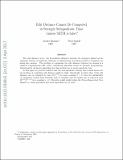Edit Distance Cannot Be Computed in Strongly Subquadratic Time (unless SETH is false)
Author(s)
Backurs, Arturs; Indyk, Piotr
DownloadEdit distance.pdf (181.5Kb)
OPEN_ACCESS_POLICY
Open Access Policy
Creative Commons Attribution-Noncommercial-Share Alike
Terms of use
Metadata
Show full item recordAbstract
The edit distance (a.k.a. the Levenshtein distance) between two strings is defined as the minimum number of insertions, deletions or substitutions of symbols needed to transform one string into another. The problem of computing the edit distance between two strings is a classical computational task, with a well-known algorithm based on dynamic programming. Unfortunately, all known algorithms for this problem run in nearly quadratic time.
In this paper we provide evidence that the near-quadratic running time bounds known for the problem of computing edit distance might be {tight}. Specifically, we show that, if the edit distance can be computed in time O(n[superscript 2-δ]) for some constant δ>0, then the satisfiability of conjunctive normal form formulas with N variables and M clauses can be solved in time M[superscript O(1)] 2[superscript (1-ε)N] for a constant ε>0. The latter result would violate the Strong Exponential Time Hypothesis, which postulates that such algorithms do not exist
Date issued
2015-06Department
Massachusetts Institute of Technology. Department of Electrical Engineering and Computer ScienceJournal
Proceedings of the Forty-Seventh Annual ACM on Symposium on Theory of Computing - STOC '15
Publisher
Association for Computing Machinery
Citation
Backurs, Arturs, and Piotr Indyk. “Edit Distance Cannot Be Computed in Strongly Subquadratic Time (unless SETH Is False).” Proceedings of the Forty-Seventh Annual ACM on Symposium on Theory of Computing - STOC ’15 (2015), 14-17 June, 2015, Portland, Oregon, Association of Computing Machinery, 2015, pp. 51-58.
Version: Author's final manuscript
ISBN
978-1-4503-3536-2